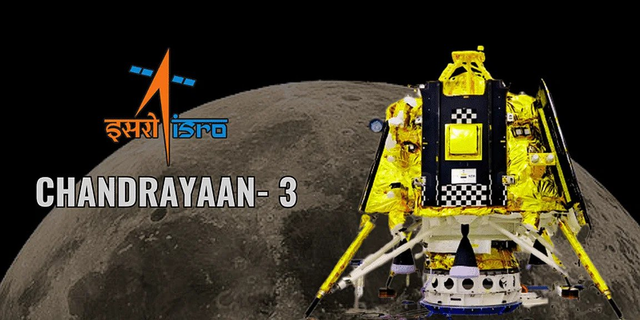
Chandrayaan-3 is the third lunar mission of the Indian Space Research Organisation (ISRO). It was launched on July 14, 2023, from the Satish Dhawan Space Centre in Sriharikota, Andhra Pradesh. The mission aims to soft-land a lander and rover on the Moon's south pole.
The Chandrayaan-3 spacecraft consists of three main components:
• A propulsion module, which will carry the lander and rover configuration to a lunar orbit of 100 kilometers.
• A lander, which will be responsible for the soft landing on the Moon.
• A rover, which will be deployed from the lander and will explore the lunar surface.
The lander is named Vikram, after the father of India's space program, Dr. Vikram Sarabhai. The rover is named Pragyaan, which means "wisdom" in Sanskrit.
The Chandrayaan-3 mission is expected to land on the Moon on August 23, 2023. If successful, India will become only the fourth country to soft-land a spacecraft on the Moon, after the United States, the former Soviet Union, and China.
The mission will help scientists to learn more about the Moon's south pole, which is a region that has not been well-explored. The scientists are particularly interested in studying the presence of water ice in the lunar polar regions.
The Chandrayaan-3 mission is a major milestone for India's space program. It is a testament to the country's growing technological capabilities and its commitment to space exploration.
Scientific Objectives of Chandrayaan-3
The scientific objectives of Chandrayaan-3 are:
• To soft-land a lander and rover on the Moon's south pole.
• To study the composition and structure of the lunar surface at the landing site.
• To search for water ice in the lunar polar regions.
• To study the history of lunar volcanism and tectonism.
• To study the lunar atmosphere and dust environment.
• To develop and demonstrate new technologies for lunar exploration.
The Lander
The lander is the most critical component of the Chandrayaan-3 mission. It is responsible for the soft landing on the Moon and for deploying the rover. The lander is equipped with a number of scientific instruments, including a camera, a spectrometer, and a magnetometer.
The lander is named Vikram, after the father of India's space program, Dr. Vikram Sarabhai. It is about 1,500 kilograms in weight and is about 3 meters in height.
The Rover
The rover is a small, mobile vehicle that will be deployed from the lander. It is equipped with a number of scientific instruments, including a camera, a spectrometer, and a drill. The rover will be used to explore the lunar surface in the vicinity of the landing site.
The rover is named Pragyaan, which means "wisdom" in Sanskrit. It is about 26 kilograms in weight and is about 1 meter in length.
The Mission Timeline
The Chandrayaan-3 mission is scheduled to launch on July 14, 2023. It will take about 42 days to reach the Moon. The lander is scheduled to land on the Moon on August 23, 2023. The rover will be deployed from the lander shortly after landing.
The mission is expected to last for one lunar day, which is about 14 Earth days. The lander and the rover will then shut down and go into hibernation.
The Future of Chandrayaan
The Chandrayaan-3 mission is a major milestone for India's space program. It is a testament to the country's growing technological capabilities and its commitment to space exploration.
The success of Chandrayaan-3 will pave the way for future lunar missions, such as Chandrayaan-4, which is planned to launch in 2024. Chandrayaan-4 will also land on the Moon's south pole, but it will also include a lander and a rover.
The Indian Space Research Organisation is also planning to send a human mission to the Moon in the future. Chandrayaan-3 is a major step towards achieving this goal.